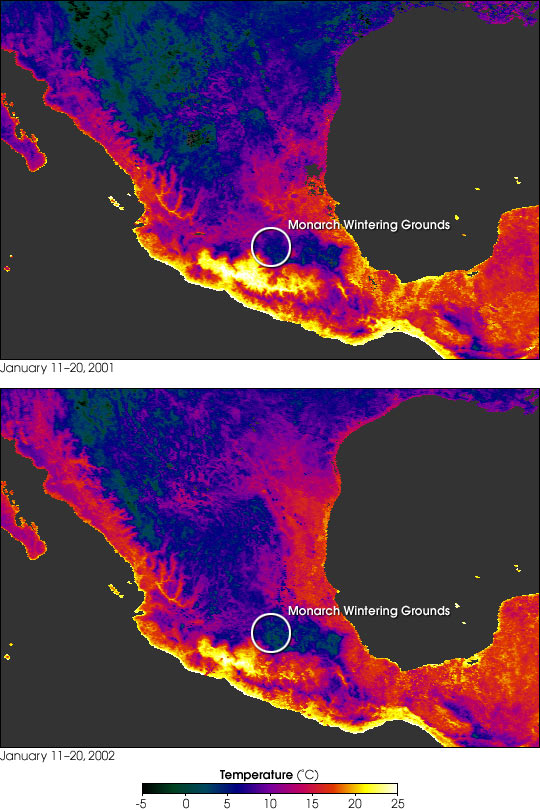


Like migratory birds and many retired couples, monarch butterflies head south for warmer weather in the wintertime. During the summer hundreds of millions of monarchs live and breed throughout the eastern United States and southern Canada. As the fall equinox approaches and temperatures begin to drop, they fly southwest through Texas and into central Mexico. Here they congregate by the millions at high altitude in fir forests on 12 separate mountain ranges until the spring Equinox. They then reverse the course of their migration and travel north again.
This winter, however, the monarch migration ended in disaster. On January 12, 2002, a winter storm blew in over central Mexico. The cold temperatures and rain wiped out up to 250 million (80 percent) of the monarch butterflies nesting in Mexico. These false color images taken by the Moderate-resolution Imaging Spectroradiometer (MODIS) aboard NASA’s Terra satellite show the average land surface temperatures across Mexico from January 11-20 for 2001 and 2002. As is indicated by the increase in the green and dark green pixels, much more of the land’s surface was freezing in the monarch’s habitat this year than in the last.
The freezing temperatures may have not been the sole reason for the monarch’s demise. Intense logging in the mountains of Mexico have degraded the fir forest by 44 percent over the past 28 years. The monarchs cluster in the branches of mature trees and shelter themselves from the elements. With the forests substantially thinned and reduced, the monarchs were more exposed to the harsh winds and rains of the winter storm that hit on January 12th. Were the forests left intact, a higher percentage of the monarchs may have lived. But given the millions of monarchs that did survive, scientists predict that the insects should pull through despite the storm and return again to Mexico next year.
References:
Anderson, J. B., and L. P. Brower. 1996. Freeze-protection of overwintering
monarch butterflies in Mexico: critical role of the forest as a blanket and
an umbrella. Ecological Entomology 21:107-116.
Calvert, W. H., W. Zuchowski, and L. P. Brower. 1983. The effect of rain, snow, and freezing temperatures on overwintering monarch butterflies in Mexico. Biotropica 15:42-47.
Brower, L. P., G. Castilleja, A. Peralta, J. Lopez-Garcia, L. Bojorquez-Tapia, S. Diaz, D. Melgarejo, and M. Missrie. 2002. Quantitative changes in forest quality in a principal overwintering area of the monarch butterfly in Mexico: 1971 to 1999. Conservation Biology 16:1-15.
Image by Robert Simmon, based on the data sets prepared by the MODIS Land Surface Temperature Group, University of California at Santa Barbara